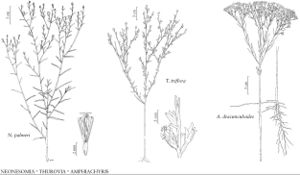Amphiachyris
Trans. Amer. Philos. Soc., n. s. 7: 313. 1840.
| Taxon | Illustrator ⠉ | |
|---|---|---|
 | Neonesomia palmeri Thurovia triflora Amphiachyris dracunculoides | Yevonn Wilson-Ramsey Barbara Alongi Barbara Alongi |
Annuals, 20–100 (–200) cm (glabrous, with strong terpenoid smell when crushed; taprooted). Stems erect, usually branched distally (bases usually lignescent). Leaves cauline; alternate; sessile; blades (1-nerved or 3-nerved) linear to lanceolate, margins entire, faces gland-dotted. Heads radiate, in paniculiform or corymbiform arrays. Involucres narrowly campanulate to turbinate, 2–4 mm diam. Phyllaries 12–15 in 1–2 (–3) series, 1-nerved (nerves without green margins) ovate, unequal, proximal 2/3 indurate, margins hyaline, faces whitish resinous. Receptacles flat to slightly convex, smooth (glabrous or hairy with multicellular, 1-seriate hairs), epaleate. Ray-florets 7–12, pistillate, fertile; corollas yellow, sometimes drying orange-tinged. Disc-florets 10–21, functionally staminate; corollas yellow, tubes shorter than cylindric throats, lobes 5, erect, deltate; style-branch appendages fused (pappi of 5–8 white, basally connate, linear, spatulate-tipped scales in 1 series, ± equaling corollas). Cypselae (ray, purplish black) obovoid-turbinate, plump, 4–9-ribbed (apices attenuate to slightly clavate), faces densely long or short-setulose (hairs appressed, white), mostly occurring in lines between ribs; pappi coroniform. x = 4, 5.
Distribution
c United States
Discussion
Species 2 (2 in the flora).
Amphiachyris was recently treated within a more inclusive Gutierrezia (G. M. Diggs et al. 1999); apparently, it is more closely related to monotypic Thurovia than to Gutierrezia (Y. Suh and B. B. Simpson 1990). Amphiachyris is distinguished from Gutierrezia by a combination of glandular hairs only on the abaxial leaf faces, functionally staminate disc florets, disc pappi of basally connate, narrowly spatulate scales ± equaling corollas, and abaxial nerves of the phyllaries without green borders.
Selected References
Lower Taxa
Key
| 1 | Plants 20–40(–60) cm; heads in open paniculiform arrays; cypselae 4–6-ribbed, long-setulose; leaf blades 0.2–1(–2) mm wide; receptacles with hooked, swollen-based hairs | Amphiachyris amoena |
| 1 | Plants 30–100(–200) cm; heads in crowded corymbiform arrays; cypselae 7–9-ribbed, short-setulose; leaf blades 0.5–6 mm wide; receptacles glabrous | Amphiachyris dracunculoides |